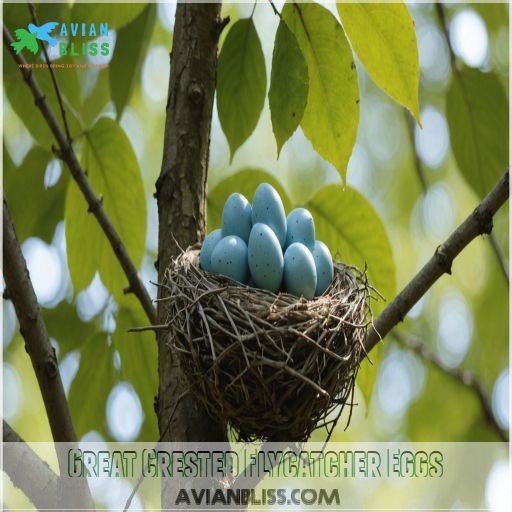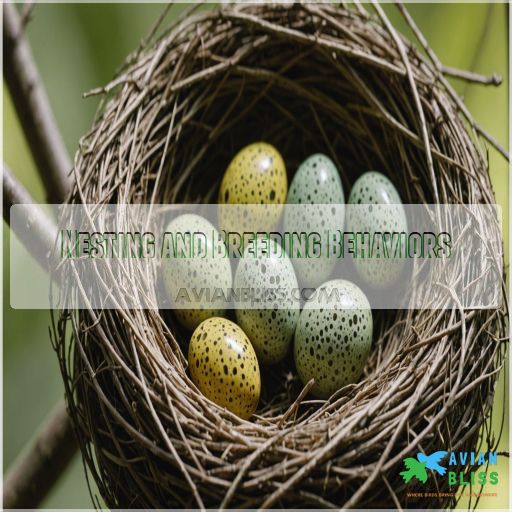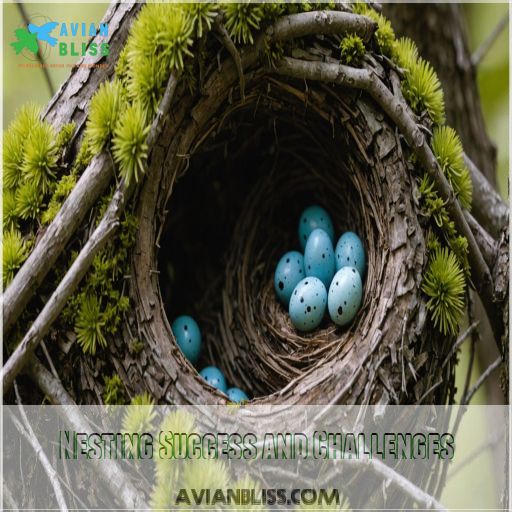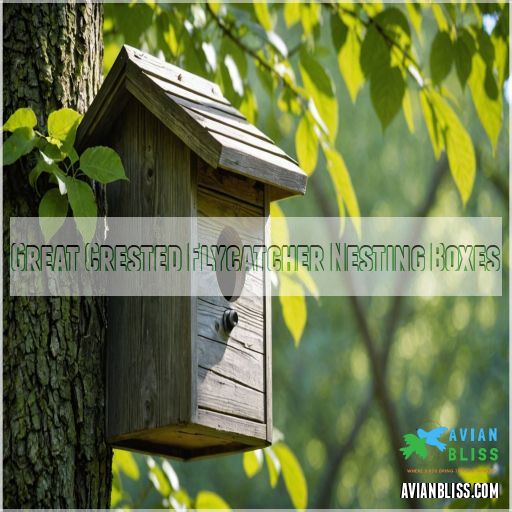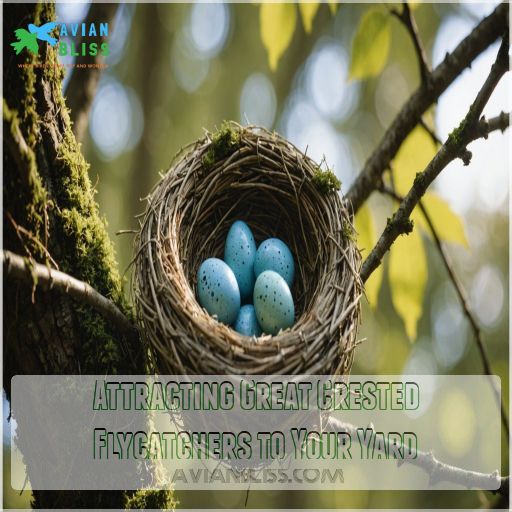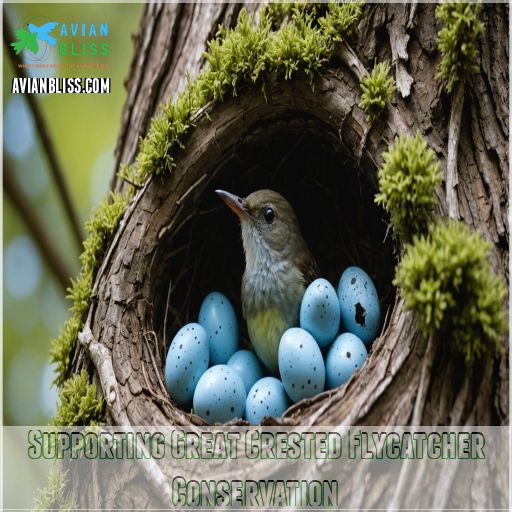This site is supported by our readers. We may earn a commission, at no cost to you, if you purchase through links.

And their eggs? Absolutely stunning – creamy white with reddish-purple speckles that camouflage them perfectly. The female flycatcher works hard, weaving in unique materials like snakeskin to build the nest.
Once the 4-8 eggs are laid, both parents take turns incubating and feeding the hungry chicks. With their resourceful nesting skills, these feisty flycatchers thrive in diverse habitats. Get ready to be captivated by their fascinating nesting secrets!
Table Of Contents
- Key Takeaways
- Great Crested Flycatcher Nesting Habits
- Nest Location and Height
- Nesting Cycle and Timeline
- Great Crested Flycatcher Eggs
- Nesting and Breeding Behaviors
- Nesting Success and Challenges
- Great Crested Flycatcher Nesting Boxes
- Attracting Great Crested Flycatchers to Your Yard
- Conservation Status and Threats
- Supporting Great Crested Flycatcher Conservation
- Frequently Asked Questions (FAQs)
- Where do Great Crested Flycatchers nest?
- Do flycatchers return to the same nest?
- How long do baby flycatchers stay in the nest?
- How long does it take for a flycatcher’s eggs to hatch?
- What distinctive vocalizations do they produce near nests?
- How do male flycatchers defend their nesting areas?
- What materials are avoided in nest construction?
- How does weather affect egg-laying patterns?
- Can their nests attract other bird species?
- Conclusion
Key Takeaways
- You’ll be amazed by the great crested flycatcher’s clever nesting habits – they love tucking their cozy nests into natural cavities or even human-made structures like buckets and pipes. Their stunning eggs are creamy white with reddish-purple speckles that camouflage them perfectly.
- These resourceful birds will cheerfully incorporate everything from snake skins to cellophane into their nests, whether they’re high up in an old woodpecker hole or nestled inside human-made structures. Installing nesting boxes for them is like setting the stage for a bird’s Broadway – just make sure to predator-proof them and place them 6-20 feet high.
- Discovering the ideal nesting spots for great crested flycatchers can be as unpredictable as finding the last matching sock in the laundry! These birds choose nesting locations at various heights, from 2 to 70 feet, adapting to different environments based on available cavities and surrounding habitat.
- To attract great crested flycatchers to your yard, plant berry-producing shrubs and trees to provide tasty treats that complement their insect-heavy diet, and offer suitable nesting sites like natural cavities or properly designed nest boxes. Minimize disturbances and protect nests from predators to create a flycatcher-friendly habitat.
Great Crested Flycatcher Nesting Habits
If you’re curious about the great crested flycatcher’s nesting habits, you’re in for a treat; these birds are both resourceful and slightly quirky.
They’ll cheerfully incorporate everything from snake skins to cellophane into their nests, whether they’re high up in an old woodpecker hole or nestled inside human-made structures.
Nesting Sites and Cavities
When choosing nesting sites, Great Crested Flycatchers prefer cavities.
They face competition from tree swallows, house wrens, and European starlings.
Make sure cavity size aligns with nest box design, minimizing human impact while maximizing flycatcher safety and freedom.
Nesting Materials and Construction
The great crested flycatcher’s nest is a haphazard affair, built with an eclectic mix of materials like grasses, leaves, twigs, and even snakeskin. This unique nest construction helps the birds thrive in diverse habitats, just like the mountain bluebird’s nest design.
- Varied Nesting Materials:
- Unconventional Additions:
- Adaptable Nest Design:
Nesting Box Installation and Maintenance
Installing nesting boxes for Great Crested Flycatchers is like setting the stage for a bird’s Broadway.
Predator-proof them, clean them seasonally, and place them 6-20 feet high.
Keep an eye out for success with regular monitoring.
Nesting in Human-Made Structures
Nest boxes are just the tip of the iceberg for the great crested flycatcher’s urban adaptations, especially important for nesting success. They’ll nest in buckets, pipes, or old cans! Human-made structures offer cozy nooks that attract these adventurous birds.
- Nesting Boxes: Easy habitats for flycatchers.
- Human Impact: Alter habitats positively.
- Backyard Habitats: Welcome birds home.
- Conservation Efforts: Encourage flycatcher families.
Nest Location and Height
Discovering the ideal nesting spots for great crested flycatchers can be as unpredictable as finding the last matching sock in the laundry!
These resourceful birds choose nesting locations at various heights, adapting to different environments based on available cavities and surrounding habitat.
Typical Nesting Heights and Locations
Typically, great crested flycatchers build their nests in natural cavities 10-20 feet high, favoring dead trees or abandoned woodpecker holes.
These open-woodland birds often choose nest sites near the edges of forests, parks, or orchards – ideal spots to spot their insect prey.
Variations in Nesting Heights and Locations
Explore variations in nesting heights, ranging from 2 to 70 feet.
Seek out these spectacular locations:
- Woodland edges with various cavity sizes.
- Open fields adjacent to tree lines.
- Suburban parks with scattered trees.
- Forested areas similar to those preferred by the Eastern Phoebe and Acadian Flycatcher.
Factors Influencing Nesting Site Selection
Understanding why Great Crested Flycatchers choose certain spots for nests can help your backyard become a sought-after avian address.
They prefer habitats with suitable cavity sizes, lower predator risks, and less competition.
Consider nest height too—after all, who wouldn’t want a penthouse view?
Nesting Cycle and Timeline
You’ll find the great crested flycatcher’s nesting cycle fascinating, as they skillfully manage various stages from egg-laying to fledging with precision.
By understanding their timeline, you’ll appreciate how these birds pack a whole lot of family drama into just a few months!
Breeding Season and Nesting Period
The breeding season for great crested flycatchers kicks off in mid-April down south, gradually progressing northward.
Their nesting period wraps up by mid-August across their range.
Time it right to catch their show!
Egg-Laying and Incubation Period
Egg-laying frequency in great crested flycatchers is steady, with eggs appearing daily after nest completion.
To boost incubation success, remember these tips:
- Make sure the nest is secure
- Limit disturbances
- Provide food sources
- Offer shelter
Nestling Period and Fledging
Eggs hatch, and suddenly, your nest is bustling with life.
These little nestlings grow rapidly, demanding constant parental care.
You’ll witness fledgling behavior as they prepare to leave the nest, boosting their survival rates and independence.
Post-Fledging Care and Independence
After young flycatchers fledge, parents still lend a helping wing.
They guide fledglings to reliable food sources and warn about threats.
As time flies, fledgling survival depends on their dispersal skills, exploring newfound territories independently.
Great Crested Flycatcher Eggs
The great crested flycatcher’s eggs are a sight to behold, with their creamy white hues and striking reddish-purple markings.
From the clutch size to the egg’s unique shape and coloration, these details hold the secrets to the flycatcher’s nesting success.
Egg Description and Characteristics
Just marvel at these eggs! Each creamy white treasure reveals itself with unique reddish-purple streaks and spots.
- Egg Color: Creamy white with striking markings.
- Egg Size: About 0.88 inches long.
- Egg Shape: Similar to a small oval gem.
Clutch Size and Egg-Laying Patterns
You’re curious about nesting timing?
The Great Crested Flycatcher lays a clutch size ranging from four to eight eggs.
Their egg-laying interval is usually daily, ensuring a good chance for the young to thrive, which keeps parental care busy!
Egg Coloration and Markings
Understanding clutch size leads us to the vibrant egg coloration and markings of the great crested flycatcher.
These egg patterns aren’t just for show—they serve a camouflage role, helping them blend in.
Nature’s paintbrush is evolutionary magic!
Egg Size and Shape
The eggs of the great crested flycatcher come in a range of sizes, from around 0.88 by 0.67 inches.
Their oval shape helps insulate the developing chicks, while the speckled shells provide camouflage.
Nesting and Breeding Behaviors
You’ll enjoy learning about the great crested flycatcher’s nesting and breeding behaviors, which could rival a reality TV show.
Watch how males and females work as a team, from courtship and nest building to defending their territory like feathered gladiators.
Male and Female Roles in Nesting
Great crested flycatchers treasure their eggs.
Both males and females take part in nest site selection.
You’ll love how they split incubation duties.
Astonishing teamwork shines in roles like:
- Chick feeding
- Nest defense
- Territorial supervision
Mating and Courtship Behaviors
Imagine this: male displays that win hearts! Courtship rituals of Great Crested Flycatchers include flashy flights and inviting calls.
While males strut their stuff, females carefully evaluate, ensuring breeding success and selecting the perfect nest site.
Territorial Defense and Aggression
Fiercely guarding their nest, great crested flycatchers swoop down on intruders, using loud calls, raised crests, and aggressive posturing to defend their territory and protect their young.
Their unwavering dedication guarantees the safety of their family.
Parenting and Chick-Rearing Behaviors
Parenting in flycatchers is like a well-rehearsed dance. You’ll notice:
- Feeding strategies include insects and berries.
- Parental care involves both parents actively.
- Brooding behavior keeps nestlings warm.
- Nest defense is a shared chore.
Nesting Success and Challenges
You might think finding the perfect nesting spot is the only challenge for the Great Crested Flycatcher, but there’s more to it.
From competing for nesting cavities to predator threats, these birds face hurdles that make their nesting journey as unpredictable as a soap opera plot.
Factors Influencing Nesting Success
Understanding nesting success means considering predator pressure, nest site quality, food availability, and human impact.
Spot a cozy spot before that nosey neighbor, and you’ll fend off competition for cavities while ensuring safe baby flycatcher launches.
Common Nesting Challenges and Threats
Nest predation by squirrels, raccoons, and snakes can threaten flycatcher broods.
Habitat loss and competition for cavities from other birds also pose challenges.
Adapting to climate change and avoiding human disturbances are key for nesting success.
Nesting Failure and Re-Nesting Attempts
When nesting fails due to predation, weather impact, or cavity competition, flycatchers aren’t sitting around sulking. They’ll search for safer spots and try again.
Expect:
- Effect of weather surprises
- Unexpected nest abandonment
- Re-nesting success stories
Strategies for Improving Nesting Success
To boost nesting success, try fitting nesting boxes with snug corners—predators find them about as inviting as a cactus hug.
Sprinkle food, restore habitats, and thoughtfully select nest sites; your flycatcher guests will feel right at home.
Great Crested Flycatcher Nesting Boxes
Want to invite Great Crested Flycatchers to your backyard? Installing a custom Flycatcher nesting box could make your yard the neighborhood hotspot for these feathered friends!
Installing and Maintaining Nesting Boxes
Crafting the perfect flycatcher home starts with choosing the right nesting box.
Consider size, materials, and strategic placement to welcome these feathered friends.
- Opt for a 1 1/4" entrance hole
- Hang the box 10-20 feet high
Monitor and maintain the box to make sure a successful season.
- Check for occupancy and clean annually
Nesting Box Design and Specifications
Nesting boxes for great crested flycatchers should feature an entrance hole size of 1 1/4 inches.
Use durable box material, make sure the cavity depth is just right for safety, and integrate predator protection measures.
Mounting height matters, too!
Placement and Orientation of Nesting Boxes
Once you’ve crafted the perfect nesting box, remember placement is key.
Hang it about 10-20 feet high, on sturdy trees like oaks.
Face the entrance away from prevailing winds, adding predator guards for safety.
Monitoring and Managing Nesting Box Use
Keeping an eye on those nesting boxes helps make sure a happy flycatcher household and prevents egg drama. Regularly monitor for:
- Proper nesting box placement
- Sturdy box design
- Best monitoring frequency
- Detailed data collection
- Effective predator control
Attracting Great Crested Flycatchers to Your Yard
Transforming your yard into a haven for great crested flycatchers is easier than you might think.
By planting the right berry-producing shrubs and trees, and providing suitable nesting sites,
you can attract these charismatic birds and enjoy their lively presence all season long.
Planting Berry-Producing Shrubs and Trees
Think of your yard as a flycatcher café!
Plant berry-producing species like elderberry and serviceberry to provide tasty treats that complement their insect-heavy diet.
This simple touch in backyard conservation helps attract these vocal aviators.
Providing Suitable Nesting Sites and Cavities
When providing nesting sites for Great Crested Flycatchers, remember their habitat preferences.
Consider these tips:
- Select proper nest box design.
- Match cavity size to their needs.
- Use natural cavities when possible.
- Offer diverse nesting materials.
Creating a Flycatcher-Friendly Habitat
You’ve found the perfect nesting sites, now let’s roll up our sleeves and create a flycatcher-friendly habitat.
Start by planting berry-producing shrubs and providing water sources, boosting backyard biodiversity and offering them prime flycatcher food sources!
Avoiding Disturbances and Predators
To attract flycatchers, minimize disturbances and protect nests from predators. Avoid mowing, pruning, or loud activities near nest sites. Install predator guards on nest boxes and remove invasive plants that harbor threats.
- Reduce human activity near nests
- Safeguard cavities from predators
- Maintain a quiet, undisturbed habitat
- Eliminate invasive species that threaten nests
- Provide protective cover and safe nesting spots
Conservation Status and Threats
Discover the hidden pressures on the Great Crested Flycatcher, from habitat loss and fragmentation to the unpredictability of climate extremes.
Your surroundings might just play a bigger role than you’d expect, as these birds navigate the challenges posed by human activities and disturbances (Source).
Global and Local Population Trends
Going from gardens to broader grounds, the Great Crested Flycatcher’s population remains stable, bolstered by conservation efforts.
Check out this table to explore trends:
| Year | Population (Millions) | Habitat Fragmentation | Urbanization Impact |
|---|---|---|---|
| 2020 | 8.8 | Moderate | Positive |
| 2021 | 8.9 | Slight increase | Beneficial |
| 2022 | 8.8 | Stable | Neutral |
| 2023 | 8.8 | Stable | Neutral |
Habitat Loss and Fragmentation
Picture a jigsaw puzzle missing pieces – that’s habitat loss for Great Crested Flycatchers. Increased urban sprawl and forest fragmentation result in reduced edge habitats.
- Diminished habitat connectivity.
- Disrupted wildlife corridors.
- Threatened flycatchers’ nesting success.
Climate Change and Weather Extremes
As climate change alters migration patterns and brings extreme heat, flycatchers must adapt.
A table below shows how habitat shifts and food availability impact their nesting success.
| Habitat Shifts | Food Availability | Storm Impacts |
|---|---|---|
| Woodlands shrink | Insect declines | Nest damage |
| Edges disappear | Berries scarce | Chicks perish |
| Nesting sites lost | Starvation risks | Migrations disrupted |
Human Activities and Disturbances
While weather extremes shake up the landscape, human activities can also impact flycatcher habitats.
From noise and light pollution to pesticide use and invasive species, these disturbances shatter peace and threaten their homes—causing habitat fragmentation and nesting challenges.
Supporting Great Crested Flycatcher Conservation
You can play a key role in conserving Great Crested Flycatchers by joining citizen science projects and supporting organizations dedicated to their protection.
Imagine turning your backyard into a flycatcher’s haven with a few nesting boxes, some berry bushes, and a ‘no cats allowed’ sign to boost their population.
Participating in Citizen Science Projects
Watching for Great Crested Flycatchers? Joining citizen science projects lets you track data on these birds.
Engage in bird surveys, habitat mapping, and observe population trends, contributing valuable info while enjoying nature, just like a scientist-explorer!
Supporting Conservation Organizations and Initiatives
Support conservation groups funding habitat restoration and citizen science projects to track flycatcher populations. Join local birding clubs to learn more and get involved in hands-on conservation efforts.
Creating Flycatcher-Friendly Habitats and Communities
Imagine your yard as a flycatcher resort.
Incorporate berry bushes and open woods to attract them.
Try community gardens for a vibrant ecosystem.
Nesting box placement is key—think of it as prime real estate for urban wildlife.
Spreading Awareness and Education
Creating a flycatcher-friendly habitat sparks joy, but sharing your journey can do wonders!
- 1. Join citizen science projects to track backyard birds.
- 2. Share educational resources on flycatcher conservation.
- 3. Encourage habitat restoration in your community.
Frequently Asked Questions (FAQs)
Where do Great Crested Flycatchers nest?
Nearly every Great Crested Flycatcher nest includes snakeskin, a quirky decorating choice!
They nest in tree cavities or nesting boxes, anywhere from 2 to 70 feet high, including human-made structures like mailboxes and pipes (Source).
Do flycatchers return to the same nest?
Flycatchers often return to the same nesting sites over the years, reusing cavities or nesting boxes.
Flycatchers are adaptable and resilient, like the phoenix rising from ashes.
If nesting failed early, they might switch locations.
How long do baby flycatchers stay in the nest?
Young flycatchers fledge after about two weeks, taking flight to begin their independent lives.
Though they leave the nest quickly, their parents continue to feed and care for them for some time after.
How long does it take for a flycatcher’s eggs to hatch?
You’re in for a treat—those flycatcher eggs typically hatch in about 13 to 15 days.
With a bit of patience, you’ll watch nature’s miracle unfold right before your eyes, just like waiting for popcorn to pop!
What distinctive vocalizations do they produce near nests?
You might think all bird calls sound alike, but a Great Crested Flycatcher’s loud, harsh "wheep" near nests is like a parent’s frantic shout, alerting others to steer clear of its treasured offspring.
The call serves as a warning.
How do male flycatchers defend their nesting areas?
Male Great Crested Flycatchers fiercely protect their nests like medieval knights guarding castles.
They use calls, furrow their brows with crests raised, and engage in aerial duels, fiercely confronting any intruder who dare approach their domain .
What materials are avoided in nest construction?
Ah, the great crested flycatcher is quite the picky one in terms of nest construction!
You see, they tend to steer clear of anything too flashy or attention-grabbing, preferring a more subtle, understated approach.
No need for the latest designer materials here!
How does weather affect egg-laying patterns?
While weather impacts many birds’ egg-laying patterns, Great Crested Flycatchers typically adhere to a consistent May-July schedule.
Spring temperatures aligning with insect abundance inspire nesting, allowing fledglings the best food availability and avoiding harsh conditions .
Can their nests attract other bird species?
Imagine cozy nests woven with snakeskins and unusual trinkets.
These quirky materials might inadvertently lure other bird species, curious as cats, to investigate or even reuse these inviting spaces for their own broods.
Conclusion
Picture the great crested flycatcher’s nest as a tiny fortress, brimming with its own secrets.
These resourceful birds pair elegant egg markings with ingenious nesting choices, from tree cavities to quirky human-made spots.
You can play a key role in their success by creating a welcoming habitat, installing a nesting box, and weaving conservation efforts into your community.
With these strategies, you’ll invite a symphony of flycatchers—and their fascinating behaviors—right to your doorstep.




